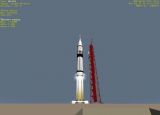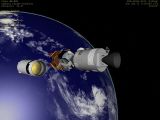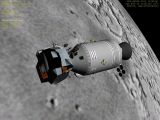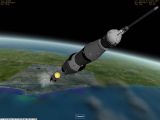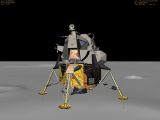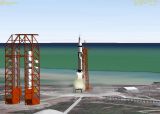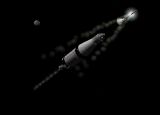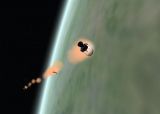Difference between revisions of "Project Apollo for Orbiter"
Mark Grant (talk | contribs) m (→Comparative screenshots: - reworded) |
|||
| Line 94: | Line 94: | ||
==Comparative screenshots== | ==Comparative screenshots== | ||
| − | NASSP changed significantly | + | NASSP has changed significantly over the years, as models, textures and control panels were updated, historical accuracy was improved and new special effects were added. |
{| border="1" cellpadding="1" | {| border="1" cellpadding="1" | ||
Revision as of 14:10, 16 August 2006
NASA's Apollo Space Simulation Project is an Addon for Orbiter which recreates the Apollo missions.
Background
NASSP was originally developed by Jean-Luc Rocca-Serra, who released the source code to version 4.x. Mark Grant then rewrote the code as C++, added an initial C++ implementation of the Apollo Guidance Computer and replaced the control panel bitmaps, releasing 'NASSP COSTAM' and a derivative which provided basic support for the Virtual AGC software.
Jean-Luc released NASSP 5.0, an updated version based on that source code, for the next release of Orbiter, including, for example, new particle exhaust support and a Skylab launch module.
With the 6.x release it became Project Apollo for Orbiter, an open source Apollo simulation add-on: for simplicity, both software variants are described here as NASSP. The latest 'stable' version is 6.4.3.
The 7.0 release is currently in Beta, including a near-complete simulation of the Command Module control panel and most of the internal systems, and support for new spacecraft. It is also capable of flying most of an Apollo mission using the Virtual AGC software.
Supported spacecraft
NASSP 7.0 supports a number of spacecraft.
'Apollo to Venus' Wet Workshop test
NASA's Manned Venus Flyby plans using Apollo technology would have used an SIVB stage to launch a three-man crew towards Venus, after which they would vent remaining fuel from the SIVB, extend solar panels and live in it as a Skylab-style space station. They would conduct generalised astronomical and zero-gravity experiments for most of their trip, and for a few days around the flyby they would conduct detailed observations of Venus.
NASSP 7.0 includes a simulation of the first test phase, in which the astronauts would use the SIVB to raise their orbit for a test of the 'wet workshop' of up to one month in duration.
Command/Service Module
NASSP simulates the Block II Command/Service Module, providing a home and life support for the astronauts in space.
Lunar Module
Two-stage lander used to land astronauts on the Moon and return them to orbit.
Lunar Rover
Electrically-powered rover used by the astronauts to drive around the lunar surface.
Saturn V
Three-stage launcher used to launch a Command/Service Module and Lunar Module towards the Moon. This was used to launch Apollos 8 to 17.
Saturn 1b
Two-stage launcher used to launch a Command/Service Module into Earth orbit. This was used for Apollo 7, the Skylab flights, and the Apollo-Soyuz Test Project flight.
Saturn INT-20
Two-stage launcher used in a similar manner to the Saturn 1b to launch a Command/Service Module and larger payload into Earth orbit: essentially a cut-down Saturn V with no second stage, mounting an SIVB stage directly on top of the S1C first stage. The S1C also had one engine removed, as the five-engine stage produced too much thrust and would have caused problems with excessive dynamic pressure during launch.
The primary benefit of the INT-20 was that it could provide a payload capacity about half-way between the Saturn 1b and Saturn V without the cost of creating a new launcher from scratch: the stages were close enough in design that they could be built on the same production line as the Saturn V stages.
Future spacecraft
There are a number of candidates for future additions to the spacecraft simulated in NASSP.
Apollo to Venus
Phase B of the Apollo to Venus plan called for the addition of solar panels to the 'wet workshop' and the use of a Block III CSM so that the astronauts would fly the SIVB into a high altitude orbit for a year-long mission in preparation for an actual fly-by.
Phase C of the Apollo to Venus plan would use an improved version of the 'wet workshop' SIVB with a Block-IV CSM to perform the actual Venus flyby.
Command/Service Module
Support may be added for the proposed Block-III CSM with batteries for power in place of fuel cells, and the Block-IV CSM with batteries for power and LEM engines in place of the SPS.
Long-Range Flyer/Lunar Escape System
Simple two-man rocket using fuel from the LEM. This could be used for scouting missions to sites up to around 50 miles from the main landing site, or, in an emergency, to carry two astronauts from the lunar surface to rendevouz with the CSM.
Saturn 1
The Saturn 1 was the precursor to the Saturn 1b, using an SIV stage in place of the SIVB. The SIV was smaller, with a lower fuel capacity, and used multiple RL10 engines in place of the J2 engine on the SIVB.
Saturn 1b MLV
As part of NASA's cost-cutting plans, they studied a derivative of the Saturn 1b which would replace the S1B stage with a solid rocket similar in size to a shuttle SRB. In essence this was a 1960s version of NASA's new 'Stick' launcher for the CEV.
Saturn INT-21
Two-stage launcher used to launch large payloads into Earth orbit. This was used for the Skylab mission.
Skylab
The NASSP 5.x Skylab sources were lost, so a new version will be required once the INT-21 support is added.
Comparative screenshots
NASSP has changed significantly over the years, as models, textures and control panels were updated, historical accuracy was improved and new special effects were added.
Historical documents
A number of historical documents have been used in NASSP development. A selection of the more important ones are:
- Apollo 15 Delco manual for AGC
- Apollo By The Numbers: A Statistical Reference. HTML or PDF
- Final Report - Studies of Improved Saturn V Vehicles and Intermediate Payload Vehicles
- Manned Venus Flyby study, Feb. 1, 1967
- NASA Marshall Spaceflight Center, Skylab Saturn IB Flight Manual, 30th September 1972
- Saturn V Flight Manual - SA-503





